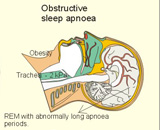
Obstructive sleep apnea (OSA) is the most common type ofsleep apnea and is caused by complete or partialobstructions of the upper airway. It is characterized by repetitive episodes of shallow or paused breathing duringsleep, despite the effort to breathe, and is usually associated with a reduction in blood oxygen saturation. Individuals with OSA are rarely aware of difficulty breathing, even upon awakening. It is often recognized as a problem by others who observe the individual during episodes or is suspected because of its effects on the body. OSA is commonly accompanied with snoring. Some use the terms obstructive sleep apnea syndrome or obstructive sleep apnea–hypopnea syndrome to refer to OSA which is associated with symptoms during the daytime.
Organism species: Mus musculus (Mouse)
| CATALOG NO. | PRODUCT NAME | APPLICATIONS | |
| Models | n/a | Model for Obstructive Sleep Apnea Hypopnea Syndrome (OSAHS) | Disease Model Customized Service Offer |
| Tissues | n/a | Tissue of Obstructive Sleep Apnea Hypopnea Syndrome (OSAHS) (If Necessary) | Tissue Customized Service Offer |
| Serums | n/a | Serums of Obstructive Sleep Apnea Hypopnea Syndrome (OSAHS) (If Necessary) | Serums Customized Service Offer |
Organism species: Rattus norvegicus (Rat)
| CATALOG NO. | PRODUCT NAME | APPLICATIONS | |
| Models | DSI813Ra01 | Rat Model for Obstructive Sleep Apnea Hypopnea Syndrome (OSAHS) | Disease Model |
| Tissues | n/a | Tissue of Obstructive Sleep Apnea Hypopnea Syndrome (OSAHS) (If Necessary) | Tissue Customized Service Offer |
| Serums | n/a | Serums of Obstructive Sleep Apnea Hypopnea Syndrome (OSAHS) (If Necessary) | Serums Customized Service Offer |
